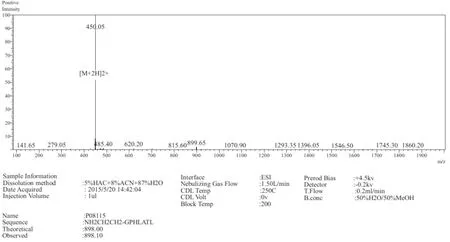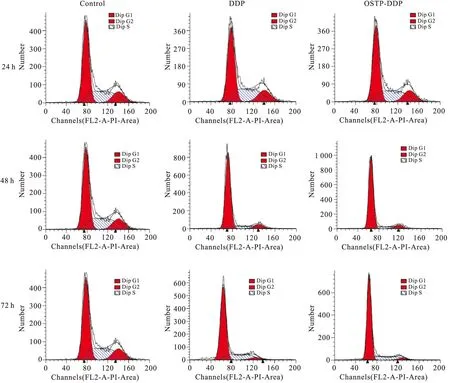OSTP-DDP靶向抑制卵巢癌A2780细胞生长作用的研究
2016-03-24李俏然卢雪琳刘小敏梁晓秋
李俏然,唐 正,卢雪琳,刘小敏,梁晓秋
(1.南华大学肿瘤研究所,湖南 衡阳 421000;2.南华大学附属第一医院临床研究所,湖南 衡阳 421001)
OSTP-DDP靶向抑制卵巢癌A2780细胞生长作用的研究
李俏然1,唐正2,卢雪琳1,刘小敏1,梁晓秋1
(1.南华大学肿瘤研究所,湖南 衡阳421000;2.南华大学附属第一医院临床研究所,湖南 衡阳421001)
中国图书分类号:R329.24;R329.25;R737.310.22;R737.310.5
摘要:目的研究卵巢癌特异性结合肽(ovarian cancer specific targeting peptide, OSTP)与顺铂(cis-dichlorodiamineplatinum, DDP)偶联物(OSTP-DDP)对卵巢癌A2780细胞的靶向抑制作用。方法化学合成OSTP-DDP,体外培养卵巢癌A2780细胞,采用CCK-8法分别检测OSTP-DDP和DDP对卵巢癌A2780细胞的生长抑制作用;通过Annexin V-FITC凋亡试剂盒分别检测OSTP-DDP和DDP对卵巢癌A2780细胞的周期和凋亡作用。结果通过质谱分析和高效液相色谱(HPLC)分析,提示成功合成OSTP-DDP。CCK-8法检测显示,OSTP-DDP与DDP分别以不同浓度(10、20、40、80、160、320 μmol·L-1)处理卵巢癌A2780细胞24、48、72 h后,均可对该细胞的生长起到抑制作用,且呈时间、浓度依赖性。且OSTP-DDP的作用强于DDP(P<0.05),提示OSTP-DDP具有靶向抑制细胞生长作用。流式细胞术检测结果显示,经OSTP-DDP和DDP处理后,细胞周期均被阻滞于G1期,作用72 h后,OSTP-DDP对卵巢癌A2780细胞的周期抑制作用强于DDP,差异具有统计学意义(P<0.05)。作用24、48、72 h后,OSTP-DDP对卵巢癌A2780细胞凋亡的作用强于DDP(P<0.01),差异具有统计学意义,提示OSTP-DDP具有较强的靶向诱导细胞凋亡作用。结论OSTP-DDP对卵巢癌A2780细胞的生长具有靶向抑制作用,OSTP作为化疗药物靶向载体治疗卵巢癌有良好的应用前景。
关键词:卵巢癌A2780细胞;OSTP-DDP;DDP;增殖抑制;凋亡;靶向治疗
卵巢癌在女性生殖系统肿瘤的发病率位居第三,但死亡率位居第一,虽然目前已有相当多针对于卵巢癌治疗的研究,但其仍然是一个致死性的疾病。因其前期多无有效的筛选方法,大多数患者确诊时已经处于晚期阶段[1-4]。目前,临床上治疗卵巢癌最常用的化疗药物为顺铂,尽管该药物在临床上使用超过30年,但该药的全身毒副作用,尤其是骨髓抑制、肾毒性和神经毒性,仍然是限制本药成为临床上有效治疗方法的一个重要因素[5]。因此,对于卵巢癌的靶向治疗显得尤为重要,同时也越来越受到重视。
本研究组利用体内噬菌体展示技术,筛选得到了卵巢癌特异性结合肽(ovarian cancer specific targeting peptide,OSTP),短肽序列PHLATLF。通过体内外实验表明,OSTP对卵巢癌A2780细胞具有特异结合作用[6]。本文进一步将OSTP与DDP偶联,观察其靶向抑制作用,为卵巢癌的靶向治疗提供理论依据。
1材料与方法
1.1实验材料卵巢癌A2780细胞购自武汉普诺赛生命科技有限公司;顺铂购自美国Sigma公司; DMEM高糖培养基、新生胎牛血清均购自美国Gibco公司; 胰蛋白酶购自长沙艾佳生物技术有限公司;CCK-8(Cell Counting Kit-8)试剂盒购自日本同仁化学研究所;Annexin V-FITC凋亡试剂盒购自Roche公司。
1.2化学合成由生工生物工程(上海) 有限公司对OSTP-DDP进行合成,并进行高效液相色谱(HPLC) 分析和质谱分析,对偶联物的性质进行鉴定。
1.3细胞培养将卵巢癌A2780细胞培养于含10%胎牛血清、100 kU·L-1链霉素、100 kU·L-1青霉素的DMEM高糖完全培养基中,置于37 ℃、5% CO2的细胞培养箱中培养,细胞贴壁生长至80%~90%左右时,加入胰酶消化传代,1周传代2~3次。
1.4CCK-8法检测细胞的生长抑制作用收集对数期细胞,调整浓度为 5×107·L-1,接种至96孔版中,每孔100 μL,置于37℃、5% CO2的细胞培养箱中孵育。待细胞贴壁且刚好铺满孔板底部,分别加入不同浓度的OSTP-DDP和DDP(10、20、40、80、160、320 μmol·L-1),每组设5个平行复孔。置培养箱中继续培养24、48、72 h后,每孔加入10 μL的CCK-8,继续培养1 h,在酶联免疫检测仪波长为450 nm处测定各孔吸光度(OD) 值。每个实验重复3次。计算公式为:抑制率/%=[(对照孔-实验孔)/(对照孔—空白孔)]×100%。OSTP-DDP和DDP均用DMSO溶解,所有实验中的DMSO终浓度均小于0.01%。空白组在此仅为计算抑制率所需,故不在分组之列。应用SPSS 18.0软件进行数据分析,偶联物的IC50值分别为24 h:55 μmol·L-1、48 h:29 μmol·L-1、72 h:25 μmol·L-1,顺铂的IC50值分别为24 h:88 μmol·L-1、48 h:47 μmol·L-1、72 h:43 μmol·L-1。
1.5流式细胞术分别检测细胞周期和凋亡① 周期:不同浓度的OSTP-DDP和DDP(55、29、25 μmol·L-1)处理A2780细胞24、48、72 h后,常规胰酶消化, PBS洗2~3次,制成单细胞悬液,并调整细胞数量至1×109·L-1。加入1 mL预冷PBS重悬细胞,800 r·min-1×5 min,吸净上清。加入400 μL PBS,轻轻重悬细胞,使细胞分离为单个,逐滴加入预冷的无水乙醇1.2 mL,使其终浓度为75%,4℃放置过夜固定。取出固定的样品,800 r·min-1,离心5 min,弃上清。加入1 mL预冷的PBS重悬细胞,800 r·min-1,离心5 min,离心收集细胞。重复1~2次,去除乙醇,加入150 μL PI(碘化丙啶)工作液,4℃ 避光染色30 min。转至流式检测管,上机检测,PI用488 nm氩离子激光器激发,由630 nm通道滤光片接收,通过FSC/SSC 散点图收集10 000个细胞,采用设门技术,排除黏连细胞和碎片,分析PI荧光直方图上各细胞周期的百分率。② 凋亡:不同浓度的OSTP-DDP和DDP(55、29、25 μmol·L-1)处理A2780细胞24、48、72 h后,用不含EDTA的胰酶消化收集,用PBS洗涤细胞2次,每次2 000 r·min-1,离心5min,收集约1~5×105细胞,加入500 μL的Binding buffer 悬浮细胞,加入5 μL Annexin V-FITC混匀后,加入5 μL Propidium Iodide,混匀,室温、避光,反应5~15 min,1 h内在流式细胞仪观察检测。

2结果
2.1成功合成OSTP-DDP通过HPLC分析,纯度>95%,OSTP-DDP中多肽序列正确,质谱分析显示,顺铂已偶联成功,分子质量为1 164.05,性状为浅棕红色粉末(Fig 1、2)。
2.2OSTP-DDP对卵巢癌A2780细胞的生长抑制作用OSTP-DDP与DDP分别以不同浓度(10、20、40、80、160、320 μmol·L-1)处理卵巢癌A2780细胞24、48、72 h后,结果显示OSTP-DDP和DDP均可对A2780细胞有生长抑制作用,且呈浓度和时间依赖性。其中,经浓度10、20、40、80 μmol·L-1处理后, OSTP-DDP对卵巢癌A2780细胞的生长抑制作用明显强于DDP(P<0.05),差异具有统计学意义(Tab 1)。OSTP-DDP的IC50值分别为24 h:55 μmol·L-1、48 h:29 μmol·L-1、72 h:25 μmol·L-1,DDP的IC50值分别为24 h:88 μmol·L-1、48 h:47 μmol·L-1、72 h:43 μmol·L-1。提示OSTP-DDP具有靶向卵巢癌A2780细胞生长的作用。
2.3流式细胞术分别检测细胞周期和凋亡将不同浓度的OSTP-DDP和DDP(55、29、25 μmol·L-1)分别作用A2780细胞24、48、72 h后,结果显示OSTP-DDP与DDP均可对卵巢癌A2780细胞产生周期抑制和诱导凋亡作用。且OSTP-DDP的效果明显优于DDP。作用48 h后,细胞周期被阻滞于G1期,OSTP-DDP与DDP两者间无明显差别;但作用72 h后,OSTP-DDP对卵巢癌A2780细胞的周期抑制作用强于DDP,差异具有统计学意义(P<0.05)。作用24、48、72 h后,OSTP-DDP对卵巢癌A2780细胞凋亡的作用强于DDP,差异具有统计学意义(P<0.01)。见Tab 2,Fig 3、4。

Fig 1 The mass spectrometry of polypeptide in OSTP-DDP

Fig 2 The mass spectrometry of OSTP-DDP
Two mass spectral analyses show that the polypeptide in the OSTP-DDP has correct sequences, OSTP-DDP has correct molecular structures, the molecular weight is 1 164.05
3讨论
卵巢癌是癌症中引起女性死亡的重要原因之一,根据国际妇产科联盟(FIGO)的分期,卵巢癌原位癌的5年生存率可达90%以上,但扩散至骨盆外后的5年生存率却低至50%以下。卵巢癌的确诊一般是在晚期(FIGO分期的三期和四期),并且预后很差[7]。目前临床上,顺铂是治疗卵巢癌的一线药物,但在使用该类药物治疗后,约有超过70%的患者出现了耐药性以及严重的全身不良反应[8]。因此,靶向治疗药物的研究和探索就显得尤为重要。

Tab 1 The growth inhibitory effect of OSTP-DDP and DDP on ovarian cancer A2780 cells
**P<0.05vsDDP

Tab 2 Effects of OSTP-DDP and DDP on the cell cycle of A2780 cells
**P<0.05vsDDP

Fig 3 Cell cycle analysis of A2780 cells treated with OSTP-DDP and DDP
A: Figures of apoptosis. Left upper quadrant reveals cells which lose cell membranes but still have nucleus, left lower quadrant reveals living cells, right upper quadrant reveals apoptotic and necrotic cells in advanced stage, right lower quadrant reveals apoptotic and necrotic cells in early stage; B: The statistical chart.**P<0.01vsDDP
研究人员将博莱霉素和依托泊苷与顺铂结合,但随后研究表明病人对该药耐受性差,有严重的胃肠道反应,并可能会导致腹部感染的发生。因其未能改善顺铂所带来的全身毒副作用,并可能会增加其他的副作用,因此该治疗方案并未取得突破性的进展[9]。
还有一些研究将重点放在特殊通路抑制剂上,如mTOR抑制剂、激酶抑制剂、MAPK通路抑制剂等。研究人员发现,在低度恶性的卵巢癌中,Ras突变后,MAPK信号通路成为活化靶点,但该靶点的活化只存在于少部分的卵巢癌临床分型1期[10]。因此,将MAPK信号通路作为作用靶点在临床治疗上是有一定困难的。另一方面,在血管内皮生长因子(VEGF)通路的靶向方面取得了一定的进展,如贝伐单抗应用于临床3期的病人治疗能明显提高其生存率[11-12]。但VEGF抑制剂可引起瘤内缺氧,诱导HIF-1α的表达以及VM(类似于血管内皮的肿瘤细胞形成的类血管)的形成,这些可能与肿瘤的侵袭和转移有关[13]。
噬菌体展示技术是近年来热门研究的分子靶向治疗技术,并且得到了长足的发展。研究人员利用随机产生的DNA序列和分子生物技术,在噬菌体表面发现了大量不同的肽序列。噬菌体展示技术与传统药物筛选方法相比,其更具有简单性、有效性和效率性[14]。而且噬菌体展示肽构成了经典生物学活性分子,如激素、神经递质、细胞因子、抗原和生长因子等的关键,从而促进了不同的生物学进程和通路的发展[15-16]。从1996年至今,研究人员利用噬菌体展示技术已经筛选出了多种与组织和肿瘤具有特异性结合的噬菌体肽[17-23],为肿瘤的靶向治疗提供了理论依据和基础。但是一般来说,噬菌体展示肽需要修饰以后才能用于临床,这是由于其自身性质所决定的[24-25]。因此,本实验室提出将OSTP与DDP相连,利用肽的靶向性将DDP更多地送入肿瘤内,增加DDP的瘤内含量,提高疗效,同时减少DDP的全身毒副作用。
在前期实验工作中,本实验室已经筛选出了卵巢癌A2780细胞特异性结合肽OSTP,并通过体内外实验验证了其靶向性。本实验在前期工作的基础上,将OSTP与DDP偶联,将不同浓度的OSTP-DDP与DDP(10、20、40、80、160、320 μmol·L-1)分别作用于卵巢癌A2780细胞。CCK-8实验方法显示,不同浓度的偶联物对卵巢癌A2780细胞的生长均有抑制作用,24、48、72 h的IC50值分别为OSTP-DDP(55、29、25 μmol·L-1),DDP(88、47、43 μmol·L-1),差异具有统计学意义,提示OSTP-DDP具有靶向作用。通过流式细胞术检测细胞周期与凋亡显示,经OSTP-DDP处理的细胞周期抑制率与凋亡率明显高于DDP组的细胞,并且差异有统计学意义(P<0.01)。进一步说明了OSTP-DDP的靶向作用。由于卵巢癌对于铂类药物的耐药性及铂类药物的全身毒副反应较多,常常导致化疗方案难以奏效,甚至失败,而靶向药物治疗可以很好地减少甚至避免这些毒副反应,减少患者的耐药性,增强患者的耐受性,从而为临床上癌症患者的治疗提供了新的方向。
参考文献:
[1]Siegel R,Naishadham D,Jemal A.Cancer statistics 2013[J].CACancerJClin,2013,63(1):11-30.
[2]Jemal A,Siegel R,Xu J Q,Ward E.Cancer statistics 2010[J].CACancerJClin,2010,60(5):277-300.
[3]Choi M,Fuller C D,Thomas C R,et al.Conditional survival in ovarian cancer: results from the SEE R dataset 1988-2001[J].GynecolOncol,2008,109(2): 203-9.
[4]Walters Haygood C L,Arend R C,Straughn J M,Buchsbaum D J.Ovarian cancer stem cells: Can targeted therapy lead to improved progression-free survival[J].WorldJStemCells,2014,6(4): 441-7.
[5]Burger R A. A new model of ovarian carcinogenesis may influence early detection strategies[J].AmJObstetGynecol,2008,198(4):349-50.
[6]Yang C,He X,Liu X, et al. OSTP as a novel peptide specifically targeting human ovarian cancer[J].OncolRep,2015,3(4): 972-8.
[7]Gavalas N G,Karadimou A,Dimopoulos M A,Bamias A.Immune response in ovarian cancer: how is the immune system involved in prognosis and therapy potential for treatment utilization[J].ClinDevImmunol,2010,7(9):160-5.
[8]Robert F,Brian N,Benjamin E,et al.Phase III trial of carboplatin and paclitaxel compared with cisplatin and paclitaxel in patients with optimally resected stage III ovarian cancer: a Gynecologic Oncology Group study[J].JClinOncol,2003, 21(17):3194-200.
[9]Jaaback K, Johnson N, Lawrie T A. Intraperitoneal chemotherapy for the initial management of primary epithelial ovarian cancer[J].CochraneDatabaseSystRev,2011,9(11):CD005340.
[10]Farley J,Brady W E,Vathipadiekal V,et al.Selumetinib in women with recurrent low-grade serous carcinoma of the ovary or peritoneum: an open-label, single-arm, phase 2 study[J].LancetOncol,2013,14(2):134-40.
[11]Burger R A,Brady M F,Bookman M A,et al. Incorporation of bevacizumab in the primary treatment of ovarian cancer[J].NewEnglJMed,2011,365(26):2473-83.
[12]Perren T J,Swart A M,Pfisterer J,et al. A phase 3 trial of bevacizumab in ovarian cancer[J].NewEnglJMed,2011,365(26):2484-96.
[13]Xu Y,Li Q,Li X Y,et al. Short-term anti-vascular endothelial growth factor treatment elicits vasculogenic mimicry formation of tumors to accelerate metastasis[J].JExpClinCancerRes,2012,31:16.
[14]Hamzeh-Mivehroud M, Alizadeh A A, Morris M B,et al. Phage display as a technology delivering on the promise of peptide drug discovery[J].DrugDiscovToday,2013,18(23-24):1144-57.
[15]Anisman H,Merali Z,Hayley S.Neurotransmitter, peptide and cytokine processes in relation to depressive disorder: comorbidity between depression and neurodegenerative disorders[J].ProgNeurobiol,2008, 85(1):1-74.
[16]Bittencourt J C. Anatomical organization of the melanin-concentrating hormone peptide family in the mammalian brain[J].GenCompEndocrinol,2011,172(2):185-97.
[17]Miller K, Wang M, Gralow J, et al. Paclitaxel plus bevacizumab versus paclitaxel alone for metastatic breast cancer [J].NEnglJMed, 2007, 357(26): 2666-76.
[18]Sandler A, Gray R, Perry M C, et al. Paclitaxel-carboplatin alone or with bevacizumab for non-small-cell lung cancer[J].NEnglJMed,2006,355(24):2542-50.
[19]Burger R A, Sill M W, Monk B J, et al. Phase II trial of bevacizumab in persistent orrecurrent epithelial ovarian cancer or primary peritoneal cancer:a Gynecologic Oncology Group Study[J].JClinOncol,2007, 25(33):5165-71.
[20]Cannistra S, Matulonis U, Penson R, et al. Phase II study of bevacizumab in patients with platinum-resistant ovarian cancer or peritoneal serouscancer[J].JClinOncol,2007,25(33):5180-6.
[21]Penson R T, Dizon D S, Cannistra S A,et al. Phase II study of carboplatin, paclitaxel, and bevacizumab with maintenance bevacizumab as first-line chemotherapy for advanced mullerian tumors[J].JClinOncol,2010,28(1): 154-9.
[22]Burger R A, Brady M F, Bookman M A, et al. Independent radiologic review of the Gynecologic Oncology Group Study 0218, Phase Ⅲ trial of bevacizumab in the primary treatment of advanced epithelial ovarian cancer, primary peritoneal cancer or fallopian tube cancer[J].GynecolOncol, 2013,131(1):21-6.
[23]Adnane L, Trail P A, Taylor I,et al. Sorafenib ( BAY 439006,Nexavar), a dual-action inhibitor that targets RAF/MEK/ERK pathway in tumor cells and tyrosine kinases VEGFR/PDGFR in tumor vasculature[J].MethodsEnzymol,2006,407: 597-612.
[24]Morishita M, Peppas N A. Is the oral route possible for peptide and protein drug delivery[J]?DrugDiscovToday,2006, 11(19-20):905-10.
[25]Fricker G,Drewe J.Current concepts in intestinal peptide absorption[J].PeptSci,1996,2(4):195-211.
The inhibitory effect of OSTP-DDP on the growth of ovarian cancer A2780 cells
LI Qiao-ran1, TANG Zheng2, LU Xue-lin1, LIU Xiao-min1, LIANG Xiao-qiu1
(1.TumorResearchInstitute,UniversiityofSouthChina,HengyangHunan421000,China; 2.ClinicalResearchInstitute,theFirstAffiliatedHospitalofUniversityofSouthChina,HengyangHunan421001,China)
Abstract:AimTo study the growth inhibitory effect of the conjugate(ovarian cancer specific targeting peptide and cisplatin,OSTP-DDP) that targeting ovarian cancer cells A2780. MethodsUsing chemical method to synthesize OSTP-DDP, ovarian cancer cells A2780 were cultured in vitro, using CCK-8 method (Cell Counting Kit-8) to detect the growth inhibitory effect of ovarian cancer A2780 cells, which were disposed by OSTP-DDP and DDP. Annexin V-FITC was used to detect the cycle and apoptosis effect of ovarian cancer A2780 cells which were disposed by OSTP-DDP and DDP. ResultsAccording to the mass spectrometry and the high performance liquid chromatography (HPLC) analysis, OSTP-DDP was proved to synthesize successfully. CCK-8 assay showed that both OSTP-DDP and DDP could play the growth inhibitory effect and showed a concentration-dependent manner when cells were treated in different concentrations (10,20,40,80,160,320 μmol·L-1) respectively after 24 h, 48 h, 72 h. And the effect of OSTP-DDP was stronger than DDP (P<0.05), indicated OSTP-DDP had targeted cytostatic effect. The result of the flow cytometry showed that cell cycle was mostly arrested in G1phase after 72h treated by OSTP-DDP and DDP,the inhibitory effect of OSTP-DDP was stronger than DDP (P<0.05).The apoptosis effect of OSTP-DDP was stronger than DDP (P<0.01),suggested that OSTP-DDP had a stronger targeting apoptosis-inducing effect. ConclusionOSTP-DDP has the targeting growth inhibitory effect on the ovarian cancer cell A2780,OSTP as a chemotherapeutic drug targeting vector has a great prospect to treat ovarian cancer.
Key words:ovarian cancer cell A2780;ovarian cancer specific targeting peptide (OSTP) and cisplatin(DDP);DDP; growth inhibition; apoptosis; targeting therapy
文献标志码:A
文章编号:1001-1978(2016)02-0204-07
doi:10.3969/j.issn.1001-1978.2016.02.012
作者简介:李俏然(1990-),女,硕士生,研究方向:卵巢癌靶向治疗,E-mail:857881181@qq.com;梁晓秋(1962-),女,博士,教授,研究方向:卵巢癌靶向治疗,通讯作者,Tel:0734-8281075,E-mail:liangxiaoqiu368@163.com
基金项目:国家自然科学基金资助项目(No 81472449, 81101988)
收稿日期:2015-10-08,修回日期:2015-11-16
网络出版时间:http://www.cnki.net/kcms/detail/34.1086.R.20160125.1557.024.html网络出版地址:2016-1-25 15:57
